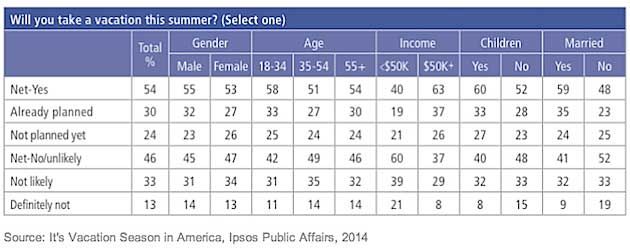More than half of Americans (54%) have already taken a vacation this summer or plan to, according to a recent report from Ipsos Public Affairs.
Not surprisingly, money is a major factor when it comes to deciding whether or not to get away: 63% of households with an annual income of $50,000+ say they have or will plan a vacation this summer compared with 40% of households with an annual income under $50,000.
Age and family status are also major influencers: Younger respondents (58%), those with children (60%), and those who are married (59%), are more likely to vacation this summer.

Below, additional key findings from the report, which was based on data from a survey of adults in the United States age 18 and older.
Why They Don't Vacation
- Of the 46% of Americans who do not plan to take a summer vacation, 64% say lack of funds is the reason they are not traveling. Women (72%) mention lack of funds significantly more than men (55%).
- 14% of respondents say they cannot get time off work and 11% say they are too busy at work.
- 11% say they simply do not feel like taking a vacation—a number that is higher for men (15%) and those who are not married (16%).
What They Look Forward To
- Sightseeing (42% of respondents) and the opportunity to spend time together as a family (36%) are the top two reasons Americans take summer vacations. The latter is especially true for households with children (53%) or spouses (43%).
- Women (32%) are more interested in outdoor activities on their summer vacations than men (17%).
- 25% of men are simply happy to be away from the office while on vacation, compared with 17% of women.

Where They Go
- 82% of respondents plan to take their summer vacation(s) in the United States only.
- International travel is more popular with households with incomes of $50,000+ (23% plan to go abroad) and respondents 18-34 years old (24%).

About the research: The report was based on data from the Ipsos US eNation online omnibus—a panel of five national online surveys. Each survey (wave of eNation) consists of a minimum of 1,000 completes with adults age 18 years or older in the contiguous United States.




